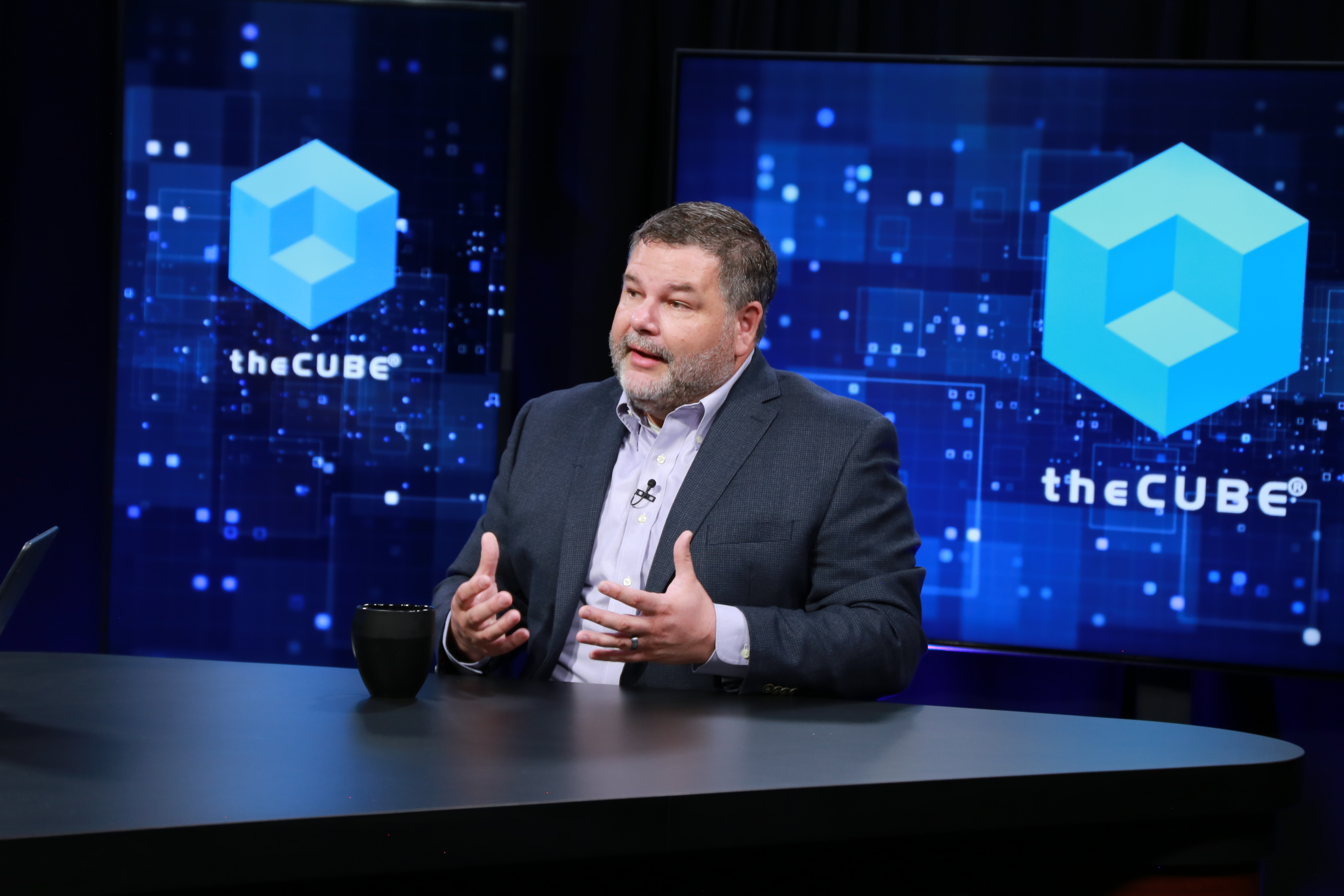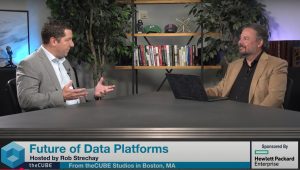 AI
AI
 AI
AI
 AI
AI
Enterprises are shifting from simply storing data to harnessing it through layered, AI-ready data platforms that integrate seamlessly across the stack. The trend is pointed toward trusted foundations designed for speed and AI-driven insights.
Such changes around AI-ready data platforms were a major focus of theCUBE’s coverage of the Future of Data Platforms Summit. It’s important to note how these layers are evolving, how they combine into unified intelligent platforms and how they enable real-time composable data products that drive innovation, according to Rob Strechay, managing director and principal analyst at theCUBE Research.

TheCUBE’s Rob Strechay discusses AI-ready data platforms.
“Investing in a layered data platform isn’t about collecting data, it’s about harnessing it,” Strechay said during an AnalystANGLE segment on theCUBE, SiliconANGLE Media’s livestreaming studio. “It’s about enabling your teams to innovate faster, stay compliant and turn information into accurate enterprise intelligence.”
During theCUBE Research’s exclusive Future of Data Platforms Summit, Strechay explored how data platform leaders from Dell Technologies Inc., Hewlett-Packard Enterprise Co., Hammerspace Inc. and others are approaching this AI-ready data platforms trend. TheCUBE’s coverage featured interviews with executives and analysts who discussed how they’re rethinking AI-ready data platforms amid changing enterprise demands. (* Disclosure below.)
Here’s three key insights you may have missed from theCUBE’s coverage:
For years, organizations have scattered unstructured data across network-attached storage systems, on-prem, in the cloud, with vendors and in SaaS applications. For data orchestration company Hammerspace Inc., there’s an effort underway to address this challenge by bringing visibility and manageability to that chaotic data landscape.

TheCUBE’s Rob Strechay and Hammerspace’s Sam Newnam talk during the Future of Data Platforms Summit.
“Gone are the days of massive volumes and proprietary replication. We’re looking at millions and billions of files being fed into AI every day,” said Sam Newnam (pictured), senior director of AI solutions at Hammerspace, during the Future of Data Platforms Summit.
To manage modern datasets, people need the ability to move them, understand their tiers and ensure they can span protocols, providers and geographies. This requires a platform that understands both file systems and the complexity of data usability, according to Newnam.
Usability challenges with distributed data create significant obstacles for data and AI teams, posing particular difficulties for AI and agentic application development. Unlike humans who can interpret file directories, applications and agents making real-time decisions require organized data from everywhere, Newnam pointed out.
“They don’t have that same cognitive ability to make decisions on data,” he said. “So, now we have to have truly organized, accessible and usable data tied to these particular agents and the applications that are using them,” he said. “We see a lot of these teams struggling because they simply can’t organize the data at the right place at the right tier or at the right time.”
Simplification comes from a global namespace that provides visibility, while automation ensures data pipelines deliver reliably and on time. There’s also a focus on acceleration, focused not only on GPU speed but on optimizing overall pipeline performance, Newnam added.
“How do I get all of that data lined up where it needs to be at the right time? We think we can bring customers 50% faster to understanding their data and using those data in the applications, not just the latency of that data underneath the GPU,” he said.
Here’s theCUBE’s complete interview with Sam Newnam:
Data platforms are shifting from passive storage to active, AI-ready foundations. In partnership with Nvidia Corp., Dell Technologies Inc. has embodied this AI-ready data platforms trend through a composable, modular data platform that unifies structured and unstructured data while ensuring security and AI readiness.
Many customers in regulated industries must keep sensitive data on-premises yet still want to leverage its high value for AI applications, according to Vrashank Jain, director of product management at Dell. That makes secure high-performance on-prem platforms just as important as cloud-native ones.
“Because of those trends, I would say our vision is to unify the structured and unstructured data, make it AI-ready by default and secure it efficiently within the customer’s enclaves at high performance,” Jain said during the event.
Developed with Nvidia, Dell’s AI Data Platform is a composable, modular ecosystem that combines “data engines” and “storage engines.” PowerScale and ObjectScale provide the secure, resilient storage backbone, which integrates with best-in-breed data engines to form a full pipeline from ingestion through analytics to AI deployment, according to Geeta Vaghela, strategy and planning for AI and technical computing at Dell.
“Whether it be the enterprise or the neo clouds or anyone in between, and whether it’s dev test or going all the way into production, the intention of our AI DP is to be composable enough and an open ecosystem so that they can combine best-in-breed technologies for various different outcomes,” Vaghela said.
Here’s theCUBE’s complete interview with Geeta Vaghela and Vrashank Jain:
Hewlett Packard Enterprise Co. and Nvidia Corp. also exemplify this shift, recently extending their partnership to include AI-optimized storage. For too long storage only wrote and read data, but now it must do more by unlocking value directly within the platform, according to Ed Beauvais, director of product management — AI and cloud data infrastructure — at HPE.

HPE’s Ed Beauvais talks with theCUBE about enterprise storage.
“That’s why we focused on introducing data intelligence that’s in-line in the platform,” he said during the Summit. “As you’re landing data, we can help unlock that value, and I think that is really one of the core tenets of what we’re trying to do,” he said during the event.
Enterprise customers want solutions that are easy to manage and deploy. That’s set to be a continued focus moving forward, Beauvais added.
“The great news from our perspective, whether that’s AI, whether that’s data analytics, a data lakehouse, all those things are really enabled with this next-generation infrastructure for both unstructured data, as well as enabling these applications. That’s our goal,” he said.
Here’s theCUBE’s complete interview with Ed Beauvais:
Beyond unifying data and building AI-first foundations, enterprises are realizing that lasting business outcomes from AI-ready data platforms depend on trust, security and governance. From sports to finance, organizations are investing in unified ecosystems that connect data while ensuring it is consistent and responsibly managed.
For NFL Enterprises LLC, this trend is illustrated by showing how a unified data ecosystem can do everything from enhancing player safety to deepening fan engagement. The NFL built a central data analytics function anchored by a unified ecosystem to modernize data products at scale and support all business domains across the organization, according to Joe Steinke, senior director of data management at NFL Enterprises.
“The idea that we could bring a central function in that could produce some standards and operational consistency throughout the league is really what drove our decision to step back and create this ecosystem,” Steinke said.
Collaboration has driven the NFL’s unified data ecosystem, improving analytics, safety, fan engagement and efficiency. Still, the NFL views its data ecosystem as a continual journey, Steinke added.
“It’s not easy to make sure you’re doing it all right, but the way we’ve approached it is to just really center with our stakeholders on their biggest needs and try to take that into account as we’re going,” he said.
Here’s theCUBE’s complete interview with Joe Steinke:
Trust and governance also defines the approach of Fair Isaac Corp., better known as FICO, which has built a reputation as a pioneer in credit scoring. For FICO, there’s been an effort to build an AI platform to untangle the complexity of financial data while still protecting the sensitive data behind it.
FICO has worked with AI and analytics for much of its history, applying that expertise to the decision intelligence market where data underpins every layer of AI and decisioning. As a result, FICO positions data as a foundational element of its platform, according to Bill Waid, chief product and technology officer at FICO.
“We do everything from the ingestion side and the storage side through all the way up to the data management layer and actually providing services around protecting that data from a data privacy perspective, as well as segmentation and cataloging, all the way through to the top end of monitoring lineage and usage and KPI measurements of the outcome,” Waid said during the event.
Here’s theCUBE’s complete interview with Bill Waid:
To watch more of theCUBE’s coverage of the Future of Data Platforms Summit, here’s our complete event video playlist:
(* Disclosure: TheCUBE is a paid media partner for the Future of Data Platforms Summit. Sponsors of theCUBE’s event coverage do not have editorial control over content on theCUBE or SiliconANGLE.)
Support our mission to keep content open and free by engaging with theCUBE community. Join theCUBE’s Alumni Trust Network, where technology leaders connect, share intelligence and create opportunities.
Founded by tech visionaries John Furrier and Dave Vellante, SiliconANGLE Media has built a dynamic ecosystem of industry-leading digital media brands that reach 15+ million elite tech professionals. Our new proprietary theCUBE AI Video Cloud is breaking ground in audience interaction, leveraging theCUBEai.com neural network to help technology companies make data-driven decisions and stay at the forefront of industry conversations.